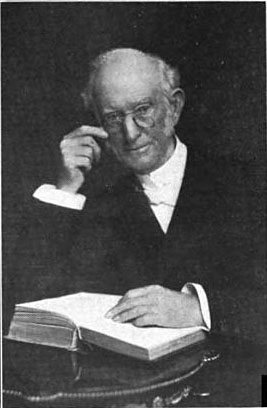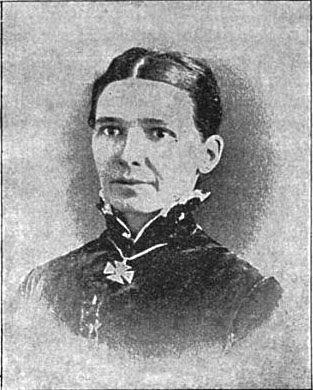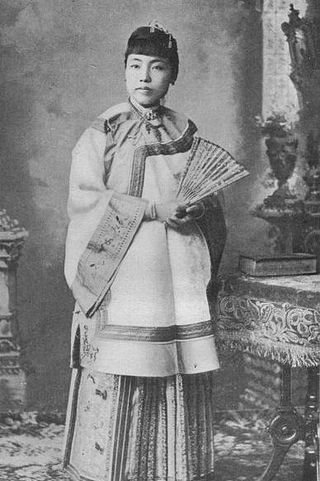
Fuzhou is the capital and one of the largest cities in Fujian province, China. Fuzhou lies between the Min River estuary to the south and the city of Ningde to the north. Together, Fuzhou and Ningde make up the Mindong linguistic and cultural region.

James Whitford Bashford was a bishop of the Methodist Episcopal Church in the United States and the first bishop of the Methodist Episcopal Church in China.

Cheeloo University was a university in China, established by Hunter Corbett American Presbyterian, and other English Baptist, Anglican, and Canadian Presbyterian mission agencies in early 1900 in China.

Robert Samuel Maclay, D.D. was an American missionary who made pioneer contributions to the Methodist Episcopal missions in China, Japan and Korea. He served as the first president of Aoyama Gakuin University.
Medical missions in China by Catholic and Protestant physicians and surgeons of the 19th and early 20th centuries laid many foundations for modern medicine in China. Western medical missionaries established the first modern clinics and hospitals, provided the first training for nurses, and opened the first medical schools in China. Work was also done in opposition to the abuse of opium. Medical treatment and care came to many Chinese who were addicted, and eventually public and official opinion was influenced in favor of bringing an end to the destructive trade. By 1901, China was the most popular destination for medical missionaries. The 150 foreign physicians operated 128 hospitals and 245 dispensaries, treating 1.7 million patients. In 1894, male medical missionaries comprised 14 percent of all missionaries; women doctors were four percent. Modern medical education in China started in the early 20th century at hospitals run by international missionaries.

Fuzhou people, also known as Foochowese, Hokchew, Hokchia, Hokchiu, Fuzhou Shiyi people (福州十邑人), Eastern Min or Mindong are residents of either Fuzhou and Mindong regions and the Gutian and Pingnan counties of Fujian province and Matsu Islands in Taiwan. Fuzhou people are a part of the Min Chinese-speaking group that speaks Eastern Min or specifically Fuzhou dialect. There is also a significant overseas Fuzhou population, particularly distributed in Malaysia, Indonesia, Japan, United States, Singapore and the United Kingdom.

Caleb Cook Baldwin was one of the first Congregationalist missionaries to Fuzhou, China.

Nathan Sites was a 19th-century Methodist Episcopal missionary who served in Fuzhou and Yanping, Fujian Province, China.

Flower Lane Church, also Huaxiang Christian Church is a Christian church in Fuzhou, China.

Church of Heavenly Peace, also known as Church of Heavenly Rest or Tien Ang Tong, is a Christian church in Fuzhou, China.

George Carleton Lacy was an American Methodist missionary and the last Methodist bishop in mainland China.

Wong Nai Siong was a Chinese revolutionary leader and educator from Minqing county in Fuzhou, Fujian province, China. He served in The Methodist Episcopal Church for many years and participated in the "Ten Thousand Word Memorial" or the "Memorial of the Examination Candidates" Petition in 1895. He also took part in the Hundred Days' Reform in 1898 and the 1911 Xinhai Revolution which resulted in the founding of the Republic of China. Wong led people from Fujian province to migrate to Sibu, Sarawak.

Mary Stone, also known as Shi Meiyu, was a doctor of medicine graduated from the University of Michigan. She founded Danforth Memorial Hospital in Kiukiang.

Hwa Nan College, or Women's College of South China, was a Christian institution of higher education founded by the Methodist Episcopal Church. It is located on the mountainside of Cangqian Mountain, now Cangshan District, Fuzhou City, Fujian Province, China. From 1938 to 1946, the college was temporarily relocated to Nanping City, due to Second Sino-Japanese War. Now the college belongs to the Cangshan Campus of Fujian Normal University.

Sigourney Trask was an American physician and missionary. She is remembered as being the first woman physician at Fuzhou, China sent by the Methodist Episcopal Church missionaries.

Hü King Eng was a physician, and the second ethnic Chinese woman to attend university in the United States, after King You Mé. Her medical career is well-documented, as she was treated as a celebrity by American media, due to the lack of even American women studying medicine at the time.

Woman's Foreign Missionary Society of the Methodist Episcopal Church was one of three Methodist organizations in the United States focused on women's foreign missionary services; the two others were the WFMS of the Free Methodist Church of North America and the WFMS of the Methodist Protestant Church.
Lucinda L. Combs-Stritmatter was an American physician who was the first female medical missionary to provide medical care in China. She is credited with establishing the first women's hospital in Beijing. Combs was a pioneer in women's medical care while serving the Women's Foreign Ministry Society's North China Mission for seven years.
The history of Methodism in Sichuan began in 1882 when missionaries began to arrive from the United States. Methodists founded or helped found several colleges, schools, and hospitals to aid in modernization and conversion efforts. Later, American Methodists were joined by missionaries from Canada. Methodism grew to become one of the two largest denominations of Protestant Christianity in the province by 1922, along with Anglicanism.
















